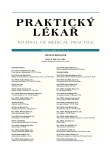Probiotics from the view of general practitioner – bacteria species used as a probiotics, their effect, safety and dosage
Authors:
D. Mazánková; S. Kotásková
Authors‘ workplace:
Ústav aplikované farmacie
; Přednosta: doc. ing. Jiří Dohnal, CSc., MBA
; Farmaceutická fakulta Veterinární a farmaceutické Univerzity, Brno
Published in:
Prakt. Lék. 2011; 91(10): 586-589
Category:
Various Specialization
Overview
The authors of this article deal with the question of probiotics, namely particular bacteria species used as a probiotics and their further use in clinical practice. Bacteria species used as a probiotics classify into two basic groups.
1. First group are bacteria of lactic fermentation. There are three kinds of them:
– Bifidobacterium,
– Lactobacillus, a
– Lactococcus.
2. In the second group there are probiotic organisms like non-pathogenic isolate
– Escherichia coli,
– Clostridium butyricum, or
– Saccharomyces boulardii.
The mechanism of probiotic effect consists in production of substances (able to inhibit bacteria) or ability to adhere to intestinal epithelium and protect adhesion sites against potential pathogenic bacteria by competitive inhibition. Next mechanism is use of nutrients by those bacteria, which would be otherwise consumed by pathogenic microorganisms. Probiotic bacteria participate in creation of vitamins and influence positively absorption of minerals (especially calcium) or function of bowel.
In comparison with other therapeutic procedures, the safety of probiotic therapy is high. Except a few cases of bacteraemia no adverse effects appeared. Minimum daily dose of probiotic preparation for successful effect is in range of 108 – 1010 CFU (concentration of colonies).
Key words:
probiotics, Bifidobacterium, Lactobacillus.
Sources
1. Švestka, T. Mikroflóra trávicího traktu a probiotika. Pediatr. praxi 2007, 8(4), s. 220-221.
2. Senok, AC., Ismaeel, AY., Botta, GA. Probiotics: facts and myths. Clin. Microbiol. Infect. 2005, 11(12), p. 958-966.
3. Furrie, E. Probiotics and allergy. Proc. Nutrition. Soc. 2005, 64, p. 465-469.
4. Krejsek, J., Kudlová, M. a kol. Nutrice, probiotika a imunitní systém II. Část: Nutrice, přirozená slizniční mikroflóra a individuální imunitní reaktivita. Pediatr. praxi 2007, 3, s. 156-162.
5. Nevoral, J. Probiotika a jejich praktické užití. Postgraduální medicína 2009, 1, s. 14.
6. Gibson, G., Angus, F. (eds.) Ingredients Handbook: Prebiotics and probiotics. Leatherhead: Leatherhead Publishing. 2000, p. 100-205.
7. Salminen, S., von Wright, A. (eds.) Lactic acid bacteria: microbiology and functional aspects. 2nd edition. New York: Marcel Dekker Inc. 1998, p. 1-72.
8. Stibůrek, O., Příbramská, V., Lata, J. Místo probiotik v léčbě (nejen) gastrointestinálních chorob. Interní Med. 2009, 1, s. 25-29.
9. Schleifer, K.H., Kraus, J., Dvorak, C. et al. Transfer of Streptococcus lactis and related streptococci to the genus Lactococcus gen. nov. Syst. Appl. Microbiol. 1985, 6, p. 183-195.
10. Frič, P. Probiotika a prebiotika v praxi. Medicína po promoci, 2007, 8(6), s. 57-60.
11. Kohout, P. Probiotika v rukou praktického lékaře. Medicína pro praxi 2009, 6(3), s. 135-139.
12. Nevoral, J. Probiotika a prebiotika. Medical Tribune 2008, 13, s. A15.
13. Kligler, B. Probiotika. Medicína po promoci 2009, 10, 1, s. 49-53.
14. Land, MH., Rouster-Stevens, K., Woods, CR. et al. Lactobacillus sepsis associated with probiotic therapy. Pediatrics 2005, 115(1), p. 178-182.
Labels
General practitioner for children and adolescents General practitioner for adultsArticle was published in
General Practitioner

2011 Issue 10
- Memantine Eases Daily Life for Patients and Caregivers
- Metamizole vs. Tramadol in Postoperative Analgesia
- Metamizole at a Glance and in Practice – Effective Non-Opioid Analgesic for All Ages
- Memantine in Dementia Therapy – Current Findings and Possible Future Applications
- What Effect Can Be Expected from Limosilactobacillus reuteri in Mucositis and Peri-Implantitis?
Most read in this issue
- Probiotics from the view of general practitioner – bacteria species used as a probiotics, their effect, safety and dosage
- Primary hyperparathyreosis due to an ectopic parathyroid adenoma in the upper mediastinum as a cause of hypercalcaemia: case report
- Recurrence of thromboembolic disease and the possibility of its prevention
- Sexuality of seniors.
